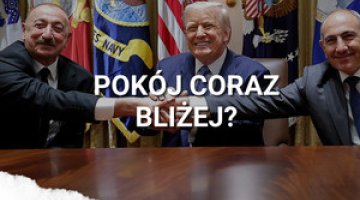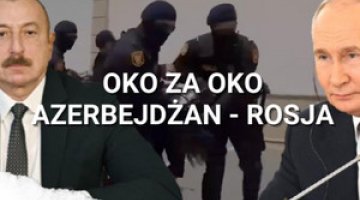Competing peace formats. Russia and the EU’s attitudes towards the Armenian-Azerbaijani conflict
Recent weeks have seen an exceptional intensification of talks between Armenia and Azerbaijan, the declared purpose of which is to normalise relations and get a peace treaty signed. Although an agreement seems closer than ever (as indicated by the Armenian Prime Minister’s explicit recognition of Azerbaijan’s territorial integrity, including Nagorno-Karabakh, and the agreement on the proposed solutions to specific contentious issues), a number of important issues remain unresolved, including the issue of security guarantees for the Armenians in Nagorno-Karabakh. In this situation, further escalations cannot be ruled out, alongside Azerbaijan’s attempts to use force in order to ‘coerce’ Armenia into peace.
Some of the talks have been held under the aegis of Moscow, while others have been mediated by the West, especially the EU (and also the US). However, the two sets of mediators have different goals and different visions of the future peace agreement. For Russia, the most important goal is to maintain its influence in the South Caucasus, which is guaranteed among other things by the presence of its peacekeepers there. It is therefore in Russia’s interest to freeze the conflict, or to achieve a merely partial settlement with Moscow as its guarantor. The EU for its part is seeking to stabilise the region, which is threatened by Russian expansionism, and to arrive at a comprehensive peace deal. Depending on which mediator eventually helps to reach an agreement, the final effect of the negotiations will not only influence this agreement’s content but will also shape the future security architecture in the region. Baku and Yerevan seem to be leaning towards the latter format. Moscow is probably aware of this, and is therefore seeking to ‘make up’ for its declining leverage over Armenia and Azerbaijan by stepping up its influence in Georgia.
The talks and the divergent views
Contacts between representatives of the Armenian and Azerbaijani leadership have been very intense in recent weeks. The leaders of the two states, Prime Minister Nikol Pashinyan and President Ilham Aliyev, recently met three times: on 14 May in Brussels, on 25 May in Moscow and on 1 June in Chișinău on the sidelines of the second European Political Community (EPC) summit. They also spoke on 3 June in Ankara during the swearing-in ceremony for Turkey’s President Recep Tayyip Erdoğan. Further meetings have been scheduled for 21 July in Brussels and 5 October in Granada, Spain, where the third EPC summit will be held. Furthermore, after the first meeting, European Council President Charles Michel announced that Aliyev and Pashinyan could hold additional meetings in Brussels as often as necessary.
The two states’ foreign ministers have also held separate negotiations. They met on 1–4 May in Washington and on 19 May in Moscow, and are planning to meet once again in Washington. A task force supervised by the deputy prime ministers of Russia, Armenia and Azerbaijan held two meetings in Moscow on 23–24 May and 1 June; this group’s tasks include making preparations to unblock transportation routes in the region.
This intense phase of the peace process indicates that both sides are willing to reach an agreement and that such an agreement is likely at hand. Baku and Yerevan argue that the purpose of the negotiations is to normalise their relations (the two sides do not maintain diplomatic relations) and to sign a peace treaty confirming this intention. This has been corroborated, for example, by Prime Minister Pashinyan’s declarations recognising Azerbaijan’s territorial integrity. He announced this intention for the first time back in April 2022 during his speech in Armenia’s parliament (see ‘Yerevan’s radical turn in its Nagorno-Karabakh policy’). However, recently he repeatedly stated openly that Azerbaijan’s territorial integrity also includes Nagorno Karabakh (Azerbaijan recognises this integrity within the borders of the former Armenian Soviet Socialist Republic). Both sides have convergent views regarding the actions that must be taken to arrive at peace; these include the unblocking of transportation routes and the delimitation of borders. On the other hand, Baku and Yerevan have deeply divergent views on several important issues such as the Armenian minority in Azerbaijan (Baku sees this as its internal matter, while Yerevan wants to obtain additional security guarantees for this group) and the status of the road linking Azerbaijan with the Nakhichevan exclave and running through Armenia (whether it should effectively be an extraterritorial ‘corridor’ or a standard transit road). Combined with the state of complete distrust between the two states, these differences may contribute to the final agreement being postponed, while the prolonged limbo increases the risk of further escalations of tension. Furthermore, it cannot be ruled out that Azerbaijan will attempt to use force to ‘coerce’ Armenia into peace. One statement by President Aliyev may be a signal that Azerbaijan is ready to launch such measures: on 28 May he called on the leadership of the Nagorno Karabakh para-state to surrender, and stated that Baku is capable of carrying out “any type of operation” on this territory. On the other hand, the presence of the EU civilian mission in Armenia (which is intended to help to stabilise the cross-border areas), the US’s diplomatic involvement and the re-election of President Erdoğan, all decrease the risk of the hostilities being resumed on a large scale.
Once it was Moscow, now it is Brussels
Since the beginning of the 1990s, the Nagorno Karabakh peace process has been monitored by the OSCE Minsk Group which is co-led by France (representing the EU), Russia and the US. Although formally the group continues to exist, it effectively suspended its activity following the Second Karabakh War in autumn 2020 (see ‘The undeclared war. A new phase of the Azerbaijani-Armenian conflict’). Since then Moscow has acted as the main mediator (indeed it was the only mediator in the first few months following the end of the war). First, it helped to achieve a cease-fire (agreed in a nine-point statement issued by Presidents Putin and Aliyev and Prime Minister Pashinyan on 9/10 November 2020) and sent its peace-keeping troops to the area of fighting; later it pressurised the two sides to adopt a conflict resolution agenda which included the formation of a task force to supervise the unblocking of the transportation routes (see ‘Górski Karabach: Kreml dyscyplinuje Baku i Erywań’). Over time, Russia proved unwilling or unable to enforce the decisions adopted or to achieve any real progress in these negotiations, despite regular meetings. Following its invasion of Ukraine, its activity in this field has decreased even further. At present, its approach to the Armenian-Azerbaijani conflict is reactive: it merely organises summits in Moscow in the wake of those held in Brussels in order to highlight its role in the peace process. Its minimum goal is to maintain its presence and its current influence in the conflict region, in particular maintaining the presence of its peace-keeping troops there (their mandate will expire in autumn 2025). This can only be achieved if the conflict remains unresolved and any future agreements are at best partial, for example if they only provide for the opening of the road to Nakhichevan (Russia is also interested in using this road, while Russian border guards are authorised to monitor its traffic, in line with the statement issued on 9/10 November 2020). Moscow has influence in the unrecognised Nagorno-Karabakh Republic (this para-state is ruled by Russian-backed politicians from the so-called Karabakh clan which also ruled Armenia until 2018) and it should be assumed that it is capable of destabilising the situation in the region to break off the peace process, should the progress of this process fail to meet its expectations.
The European Union joined the negotiations at the end of 2021 (hosting the Armenia-Azerbaijan summit held on 14 December in Brussels), with President Michel playing a major part in this initiative. In 2022, three meetings between Aliyev and Pashinyan under the aegis of the EU were held in Brussels and another one in Prague, on the sidelines of the first EPC summit. This latter meeting was held following the biggest escalation of tension since the 2020 war (in mid-September a total of almost 200 people were killed). Aside from Michel, it was attended by France’s President Emmanuel Macron. According to Baku, Macron adopted a biased, clearly pro-Armenian stance, which resulted in the ‘Brussels format’ being suspended until May 2023. The most recent meeting in Chișinău was also attended by Macron, in line with Yerevan’s demands, as well as by Germany’s Chancellor Olaf Scholz; his participation was most likely intended to offset the pro-Armenian stance adopted by France. Regardless of the ongoing talks, in autumn 2022 the EU sent an observer mission to Armenia (on the border with Azerbaijan), and in January 2023 it decided to set up a two-year European Union Mission in Armenia (EUMA). Although the EU has not had a direct impact on the situation in the region, it has used its instruments efficiently and has won the confidence of both sides (although Baku has criticised the decision to establish both missions because it fears that they may solidify the conflict, as Armenia may feel ‘protected’ by them and may be less willing to agree to compromise solutions). It is in the EU’s interest to foster stability in the neighbouring countries which are threatened by Russian expansionism. Moreover, it seeks to develop fuel supply routes for Europe which are independent of Russia (the so-called middle corridor runs through the Caucasus). This is why Brussels, with Washington’s backing, is seeking to ultimately regulate the conflict between Armenia and Azerbaijan. If this is achieved, the next step would be to normalise Armenian-Turkish relations. This in turn would equate to Yerevan receiving security guarantees.
It takes three to tango
There are many indications that both Baku and Yerevan prefer the ‘Brussels format’, and are only taking part in the ‘Moscow format’ because of their links with Moscow and for fear of its destabilising potential. As regards Armenia, which is Russia’s formal ally both bilaterally and within the Collective Security Treaty Organisation (CSTO), another motivation involves its disappointment at the lack of support from Moscow during the 2020 war and the subsequent escalations, including the most serious one in September 2022 when attacks against numerous targets on Armenian soil were launched. This frustration has manifested itself, for example, in public statements by leading Armenian politicians speculating about whether Armenia’s continued membership of the CSTO has any point (Armenia decided not to appoint a representative as CSTO Deputy Secretary General), and in Pashinyan’s interview for CNN in which he said that Armenia is not Russia’s ally in the Russian-Ukrainian armed conflict.
It seems likely that Moscow is aware of this sentiment and has been seeking rapprochement with Georgia in order to ‘make up’ for its declining influence on Armenia and Azerbaijan and to obtain an additional instrument of pressure in its relations with these two countries. Developments that corroborate this view include President Putin’s decree of 10 May which lifted visa requirements for Georgian citizens travelling to Russia and lifting the ban on direct flights between Russia and Georgia. In the situation of Tbilisi’s strategic turn towards Moscow – still very unlikely, although theoretically possible (see ‘Between Brussels and Moscow. Georgia is moving closer to Russia’) – both Armenia and Azerbaijan (which are dependent on transit via Georgia) would need to respect Russia’s interests in the region to a greater degree, while the EU would encounter numerous problems pursuing its agenda. On the other hand, should Georgia receive EU candidate status and maintain its pro-Western course, this would facilitate the efforts to reach an Armenian-Azerbaijani peace agreement in the ‘Brussels format’.





